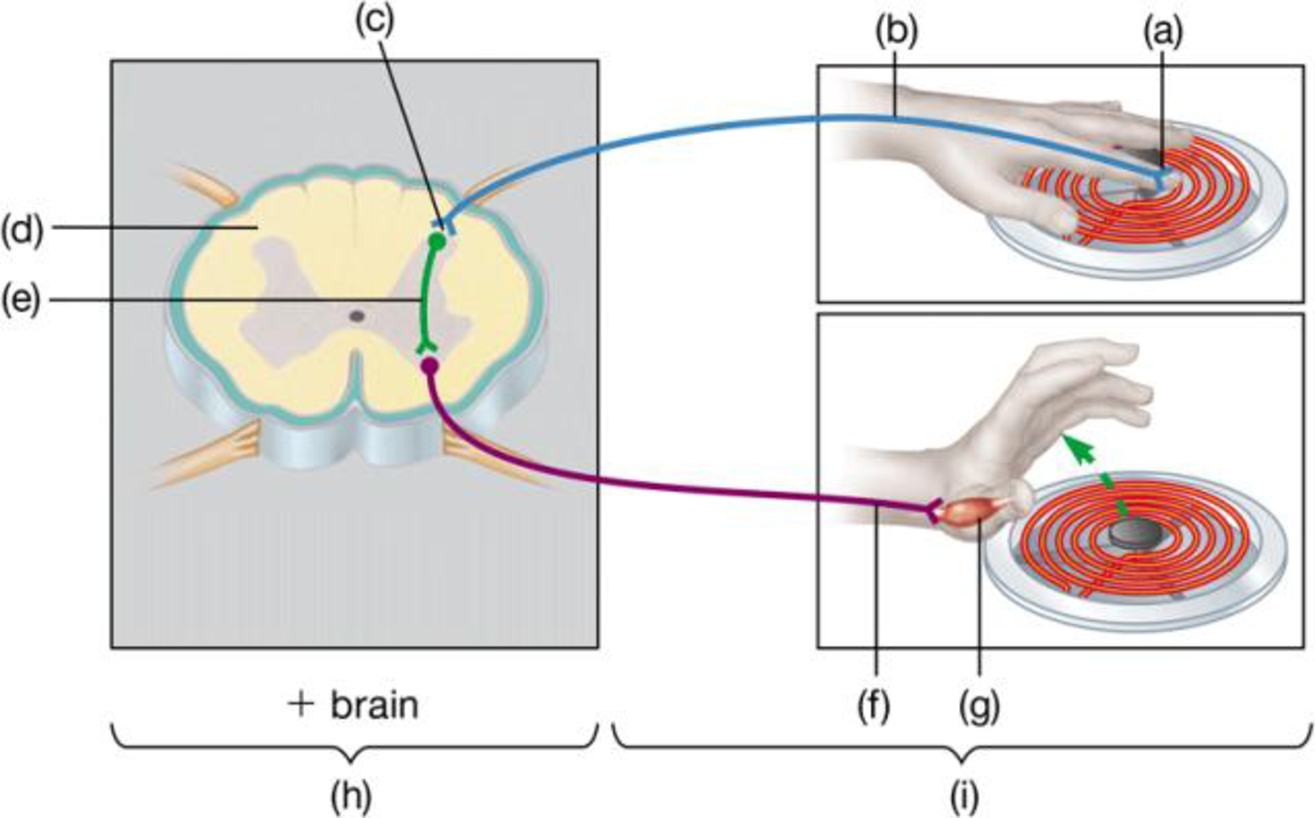
Test your understanding of the nervous system by matching the following labels with their corresponding letters: CNS, effector cells, interneuron, motor neuron, PNS, sensory neuron, sensory receptor, spinal cord, synapse.

To label: The system involved in reflex action and also to list the points that take part in conduction of nerve signals during the process.
Concept introduction: A collection of nerves, the brain, and the spinal cord that together help in regulation of signals from one part of the body to another is called the nervous system. The primary unit of the nervous system is a specialized cell that is termed as a neuron.
Answer to Problem 1CC
Pictorial representation: Fig.1 shows the systems involved in transmission of signal and response generated by the brain.

Fig.1: System involved in nerve conduction
Explanation of Solution
(a)
Correct answer: Sensory receptor.
Sensory receptors are present on dendrites to neurons that are specialized in receiving signals from the environment. The receptor that receives a signal from the external environment is termed as external sensory receptor, whereas the receptor that receives a stimulus from the internal environment is termed as an internal sensory receptor. Hence, the correct answer is a sensory receptor.
(b)
Correct answer: Sensory neuron.
Sensory neurons are the neurons that specialize in transferring the stimulus from the sensory receptor to the brain or spinal cord. The movement of stimulus through the sensory neurons is termed as sensory induction. Hence, the correct answer is a sensory neuron.
(c)
Correct answer: Synapse.
Synapse is the site where the signal passes to the next neuron or to the effector cell with the help of an electrical or a chemical signal (neurotransmitter). Hence, the correct answer is synapse.
(d)
Correct answer: Spinal cord.
The spinal cord is a part of the central nervous system. Transmission of a nerve signal from the sensory neuron to the brain for further processing is done with the help of the spinal cord and the neurons that are present in it. Hence, the correct answer is spinal cord.
(e)
Correct answer: Interneuron
Interneuron is a part of the central nervous system that helps in conveying the signals between sensory neuron and motor neuron. Interneuron is found in the spinal cord. Hence, the correct answer is an interneuron.
(f)
Correct answer: Motor neuron.
Motor neuron conducts the movement of signals from the brain and spinal cord to the cell where the response is needed. Cell body of a motor neuron is located in the spinal cord and the axon part of the cell is located toward muscle or gland where action is needed. Hence, the correct answer is a motor neuron.
(g)
Correct answer: Effector cell.
Effector cell is present in the glands and muscles. It receives the signal from the motor neuron and generates a physiological response in the body part. Hence, the correct answer is an effector cell.
(h)
Correct answer: Central nervous system.
The central nervous system (CNS) is responsible for actions that the body takes in response to an external stimulus. It receives the signal from the receptors, processes the reflex by the CNS, and transmits a signal to the effector cell. The central nervous system consists of two main parts: the spinal cord and the brain. Hence, the correct answer is the central nervous system.
(i)
Correct answer: Peripheral nervous system.
The peripheral nervous system consists of nerves and their neurons. It includes receptor cell, sensory neuron, interneuron, motor neuron, and effector cell. PNS connects the body to CNS. Hence, the correct answer is the peripheral nervous system.
Want to see more full solutions like this?
Chapter 28 Solutions
CAMPBEL BIOLOGY:CONCEPTS & CONNECTIONS
 Human Anatomy & Physiology (11th Edition)BiologyISBN:9780134580999Author:Elaine N. Marieb, Katja N. HoehnPublisher:PEARSON
Human Anatomy & Physiology (11th Edition)BiologyISBN:9780134580999Author:Elaine N. Marieb, Katja N. HoehnPublisher:PEARSON Biology 2eBiologyISBN:9781947172517Author:Matthew Douglas, Jung Choi, Mary Ann ClarkPublisher:OpenStax
Biology 2eBiologyISBN:9781947172517Author:Matthew Douglas, Jung Choi, Mary Ann ClarkPublisher:OpenStax Anatomy & PhysiologyBiologyISBN:9781259398629Author:McKinley, Michael P., O'loughlin, Valerie Dean, Bidle, Theresa StouterPublisher:Mcgraw Hill Education,
Anatomy & PhysiologyBiologyISBN:9781259398629Author:McKinley, Michael P., O'loughlin, Valerie Dean, Bidle, Theresa StouterPublisher:Mcgraw Hill Education, Molecular Biology of the Cell (Sixth Edition)BiologyISBN:9780815344322Author:Bruce Alberts, Alexander D. Johnson, Julian Lewis, David Morgan, Martin Raff, Keith Roberts, Peter WalterPublisher:W. W. Norton & Company
Molecular Biology of the Cell (Sixth Edition)BiologyISBN:9780815344322Author:Bruce Alberts, Alexander D. Johnson, Julian Lewis, David Morgan, Martin Raff, Keith Roberts, Peter WalterPublisher:W. W. Norton & Company Laboratory Manual For Human Anatomy & PhysiologyBiologyISBN:9781260159363Author:Martin, Terry R., Prentice-craver, CynthiaPublisher:McGraw-Hill Publishing Co.
Laboratory Manual For Human Anatomy & PhysiologyBiologyISBN:9781260159363Author:Martin, Terry R., Prentice-craver, CynthiaPublisher:McGraw-Hill Publishing Co. Inquiry Into Life (16th Edition)BiologyISBN:9781260231700Author:Sylvia S. Mader, Michael WindelspechtPublisher:McGraw Hill Education
Inquiry Into Life (16th Edition)BiologyISBN:9781260231700Author:Sylvia S. Mader, Michael WindelspechtPublisher:McGraw Hill Education





